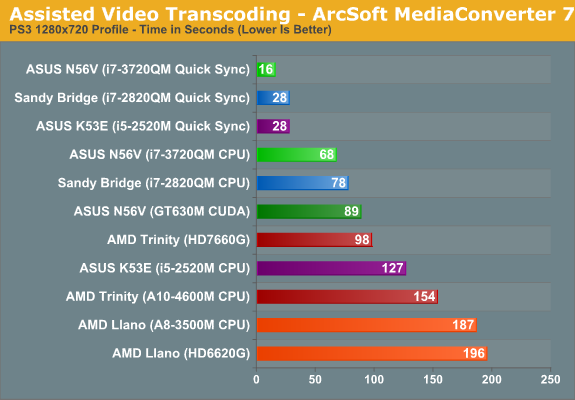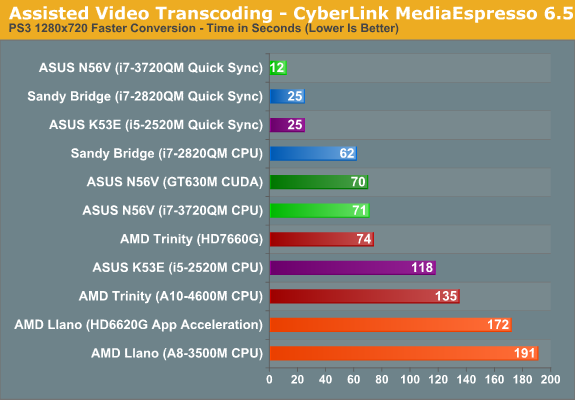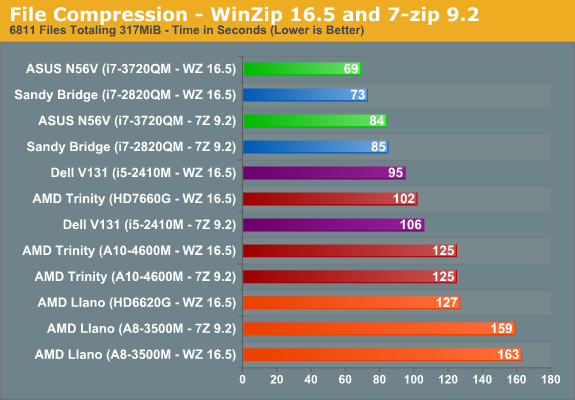The AMD Trinity Review (A10-4600M): A New Hope
by Jarred Walton on May 15, 2012 12:00 AM ESTAMD’s Heterogeneous Computing with Trinity
It’s not all about just CPU or GPU performance, though—or at least that’s what we’ve been hearing from various parties for a while now. The real question is how a platform performs as a whole. There are some tasks where pure CPU performance is what really matters, and there are other tasks where the parallel nature of GPUs pays serious dividends. AMD (and NVIDIA) has been pushing for more applications to make use of the GPU for tasks where it can provide a lot of number crunching prowess.
With Trinity, AMD provided us with a selection of applications that now leverage—to varying degrees—AMD’s App Acceleration, OpenCL, OpenGL, or other tools. For some of these applications, we don’t have any good way of measuring performance across a wide selection of hardware, and for some of those where benchmarks are possible I’ve run out of time to try to put anything concrete together. I don’t want to skip this section entirely, so what follows is a list of the applications, how they benefit from heterogeneous compute, and some general impressions of the application. We also have graphs for a few of the applications where performance seemed to matter the most.
Adobe Flash 11.2—The latest version of Flash continues to add GPU acceleration features, and now there are 3D hooks in addition to the video offload acceleration we first saw with Flash 10.x. There’s not too much of note here, as NVIDIA and Intel also support the latest features of Flash 11.2. Flash works fine on Trinity, but the same goes for Ivy Bridge and various NVIDIA GPUs. If you never saw the Epic Citadel demo for iOS or Android, there’s now a Flash-based version of the same demo that will run in your browser. (Warning: that link can take 10-15 minutes on a decent connection to download all the textures and other data!) Epic Citadel looks just as nice as it did on iOS, but now we need some actual games to take advantage of the tools. Then perhaps we can start looking into benchmarks of browser games or something….
Adobe Photoshop CS6—Photoshop started to take advantage of GPU acceleration back with the CS4 release, using OpenGL to improve performance on certain filters and features. With CS6, Adobe has begun using OpenCL. Fundamentally, I’m not sure how big of a change this represents, but there are quite a few functions in Photoshop that are now supposed to be faster/better with an OpenCL compatible graphics card. There are also two new features that leverage OpenCL; one is Iris Blur, which allows you to mimic depth of field using Photoshop instead of your camera, and the other is Liquify. Unfortunately, I’m by no means a Photoshop expert, so I’m not sure how much the features really help “power users”. I did try doing a benchmark of general Photoshop CS6 performance using the Photoshop Retouch benchmark with and without GPU acceleration enabled; unfortunately, it looks like most of the filters in that action script don’t benefit from the GPU acceleration, as the scores I got were essentially unchanged with or without GPU/OpenCL enabled. Overall, I’ll take the GPU acceleration, but for most of what I do in Photoshop it doesn’t appear to benefit; if you’re interested, you can read more about AMD’s work with Adobe.
GNU Image Manipulation Program (GIMP)—Going along with Photoshop CS6, AMD provided a special preview build of GIMP 2.8. GIMP is sort of the poor man’s Photoshop, as it’s completely free. At present, there are 19 filters that utilize OpenCL to speed of processing, and over the coming months as the release version of GIMP looks to take their new engine live there will undoubtedly be more additions. For now, probably only five of the filters are things I would use (e.g. noise reduction, maybe a light blur). I tested several of these, and there is sometimes an order of magnitude speedup vs. doing the work on just the CPU. The problem is that it also looks like GIMP isn't incredibly well threaded in many of these tasks, putting multicore CPUs at a disadvantage. My biggest complaint isn’t even about performance, though; sadly, I just find the GIMP UI and general performance to be really bad compared to Photoshop. I've tried several times over the years to use GIMP instead of Photoshop, but I’ve never felt comfortable with the tool. If on the other hand you prefer GIMP, hopefully when the current GEGL menu gets integrated into the main program you’ll realize a healthy performance boost.

ArcSoft MediaConverter 7.5—MediaConverter should be a familiar name by now if you’ve been following our reviews, as it’s one of the showcase titles for Intel’s Quick Sync transcoding. When we reviewed Ivy Bridge last month, we found that on Llano at least the version of MediaConverter we had ran slower on the GPU than on the CPU; with Trinity on the other hand, enabling GPU acceleration results in times that are about 60% faster than the CPU alone. That’s a good performance increase, but we’re looking at 154 seconds on the CPU compared to 98 seconds using the GPU. In contrast, dual-core Sandy Bridge on CPU transcoding took 127 seconds and with Quick Sync it only took 28 seconds—a 5X improvement. Quad-core Ivy Bridge was just as impressive, going from 68 seconds on the CPU down to 16 seconds with Quick Sync (4.25X). We’ve been hoping to see something more from AMD’s new Video Codec Engine (VCE), first announced over six months ago with HD 7970, but unless there’s substantial room for improvement it looks like Intel’s Quick Sync will continue to be the fastest transcoding tool for now.

CyberLink MediaEspresso 6.5—This tool is very similar to MediaConverter, and the results are also better this time around. We measured the assisted encode time at 74 seconds compared to 135 seconds on the CPU alone. The 74 second transcode time actually makes Trinity potentially faster than CPU-based transcoding on dual-core Sandy Bridge, but again Quick Sync (25 seconds on SNB, 12 seconds on IVB) remains the fastest way to transcode. Considering both of these tools are apparently using VCE, I have to state that I’m disappointed; with VCE I was expecting performance similar to what Intel is getting with Quick Sync—four or five times faster than CPU-based encoding for the same APU. That Trinity isn't quite twice as fast with VCE is unfortunate; even though there's a decent improvement, Intel is in a completely different category of performance. We’ll have to wait and see if anything more develops with VCE.

Handbrake— Yep, this popular open source video transcoding app is getting an OpenCL facelift. Check out our separate post on it here.
WinZip 16.5—This final application is one that I can see being very useful, assuming we see similar advancements in other compression utilities. WinZip 16.5 now supports OpenCL to improve compression times. We tested by compressing the entire Cinebench 11.5 directory with and without OpenCL enabled, and we also compared the results with 7-Zip. On Trinity, performance improved by about 20%, which is decent; Llano sees an even larger 28% improvement. Meanwhile, Sandy Bridge using CPU-based compression is about as fast as Trinity with OpenCL, and Ivy Bridge is still faster, but the 20% increase for “free” is nothing to scoff at. Unfortunately for WinZip, 7-Zip compressed the same directory to 95MB vs. 108MB in roughly the same time as the non-OpenCL WinZip, and 7-Zip is completely free and doesn't nag you and tell you to buy it. Where WinZip 16.5 is a good proof of concept, what will really help AMD is if all the other compression utilities (7-Zip, WinRAR, etc.) all start using OpenCL or other tools to improve performance.
The majority of the applications continue to focus on video and image manipulation, likely because those are areas where the parallel nature of GPUs can be readily utilized. WinZip on the other hand is an application showing other potential uses for GPGPU and heterogeneous compute. We’d love to see even more adoption of OpenCL and similar tools, but the stark reality is that coming up with new and useful ways of doing this is difficult—if it were easy, everyone would do it! The good news is that giving the creative people of the world more tools with which to work can only help, and we’ll just have to wait and see what else comes out.
There’s another interesting sidebar worth mentioning here. OpenCL is an open standard, and the latest Intel drivers actually install an OpenCL driver on Ivy Bridge and Sandy Bridge. Not surprisingly, not all implementations are created equal, so even with Intel’s drivers we couldn’t enable OpenCL in Photoshop or WinZip; GIMP on the other hand apparently worked okay with OpenCL on Intel—we measured a 5X performance improvement of the Noise Reduction filter with Ivy Bridge. Trinity also came in slightly faster with both leveraging OpenCL, while Intel was nearly twice as fast without.










271 Comments
View All Comments
Taft12 - Tuesday, May 15, 2012 - link
He said "better".http://ir.amd.com/phoenix.zhtml?c=74093&p=irol...
"Linux OS supports manual switching which requires restart of X-Server to switch between graphics solutions."
They ain't there yet!
JarredWalton - Tuesday, May 15, 2012 - link
Enduro sounds like it's just a renamed "AMD Dynamic Switchable Graphics" solution. I haven't had a chance to test it yet, unfortunately, but I can say that the previous solution is still very weak. And you still don't get separate driver updates from AMD and Intel.Spunjji - Wednesday, May 16, 2012 - link
Drivers is the big deal here. I like that I get standard drivers using my Optimus laptop.What I don't like is that it f#@!s up Aero constantly and occasionally performs other bizarre, unpredictable manoeuvres.
ToTTenTranz - Tuesday, May 15, 2012 - link
Greetings,Is it possible to provide some battery life results with gaming?
It's true that an Intel+nVidia Optimus solution should be better for both plugged-in gaming and wireless productivity (more expensive too, but that's been covered in the review).
However, a 35W Trinity should consume quite a bit less power than a 35W Intel CPU + 35W nVidia GPU, so it might be a worthy tradeoff for some.
Furthermore, when are we to expect Hybrid Crossfire results with Trinity+Turks? Is there any laptop OEM with that on the roadmap?
That should give us a better comparison to Ivy Bridge + GK107 solutions, as it would provide better gaming performance at a rather small price premium ($50 the most?).
x264fan - Tuesday, May 15, 2012 - link
thanx for the nice review author, but let me write you some very important information regarding your test.1. x264 HD Benchmark Ver. 4.0 you used is using quite old x264.exe for encoding. It is important for Bulldozer/Piledriver to replace it with the newer once which contain specific assembler optimisation, which gives nice performance boost for AMD processor by using new instructions introduced in those CPUs. You can find how many they are here:
http://git.videolan.org/gitweb.cgi?p=x264.git;a=sh...
I would suggest to download new x264 build from x264.nl and replace it, then run the benchmark again. It would also show you how beneficial new isntructions are.
Another suggestion would be to run this benchmark using x64 build of the x264 throught x86 avisynth wrapper avs4x264mod.exe In this way you can see how much difference x64 uinstructions give.
iN FACT X264 IS SO NICELLY OPTIMISED IT CAN BE USED FOR CPU TESTING.
2. You have used Media Player Classic Home Cinema Edition for measuring playback of h264 streams and battery life. So am I, unfortunatelly every time I want to use it with DXVA acceleration on my i7-2630 laptop I end up with terrible artefacts on smaller bitrate content. Blocks are floating and destroying picture quality. It is not as much visible on Blu-Ray content where the picture is more recommpressed than recreated using x264 transformations, but it is still there. My point is that if the INTEL decoding/drivers are so buggy which makes this dxva mode so unusable, how can anyone would like to measure battery life with this mode?
Without DXVA intel numbers would not be so good, but so far this mode is only usable.
3. I must say i am amased how good hd4000 is, but what about picture quality. From time to time we see the reports that nvidia or amd has cheated in drivers sacrifacing picture quality, so how about intel...
I hope you read my comment and update your test.
JarredWalton - Tuesday, May 15, 2012 - link
So, help me out here: where do I get the actual x264 executables if I want to run an updated version of the x264 HD test? We've tried to avoid updating to newer releases just so that we could compare results with previously tested CPUs, but perhaps it's time to cut the strings. What I'd like is a single EXE that works optimally for Sandy Bridge, Ivy Bridge, Llano, and Trinity architectures. And I'm not interested in downloading source code, trying to get a compiled version to work, etc. -- I gave up being a software developer over a decade ago and haven't looked back. :-)x264fan - Wednesday, May 16, 2012 - link
http://x264.nl it is newest semi-official build. It contains all current optimisations for every CPU, but since its command line you can turn on and off them. I also heard that this week there will be new hd benchmark 5.0 which would have the newest build in it.plonk420 - Monday, July 9, 2012 - link
the problem with this is that then the test isn't strictly "x264 hd benchmark version x.00" ... and would be harder to compare to other runs of the same test.if they did this in ADDITION to v4.00 or whatever (and VERY clearly noted the changes), that might be some useful data.
jabber - Tuesday, May 15, 2012 - link
....how about adding a line/area to the benchmark graphs that stands for "Beyond this point performance is pointless/unnoticeable to the user".That way we can truly tell if we can save ourselves a boat load of cash. All out performance is great and all but I don't run benchmarks all day like some here so it's not so important. I just need to know will it do the job.
Or would that be bad for the sponsors?
bji - Tuesday, May 15, 2012 - link
It is an interesting idea but it would such incredible fodder for fanboys to flame about, and even reasonable people would have a hard time deciding where that line should be drawn.I think the answer to your basic question is that, any mobile CPU in the Llano/Trinity/Sandy Bridge/Ivy Bridge lines will be more than sufficient for you or any other user *unless* you have a specific task that you know is highly CPU intensive and requires all of the CPU you can get.